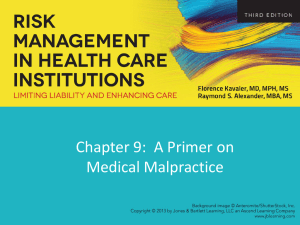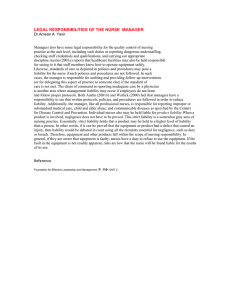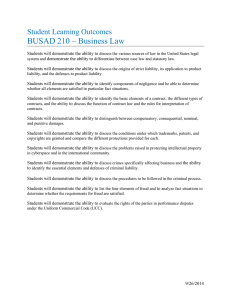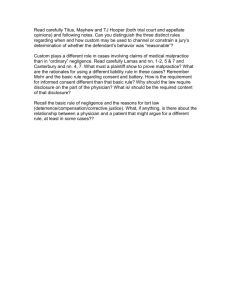trends and issues
advertisement
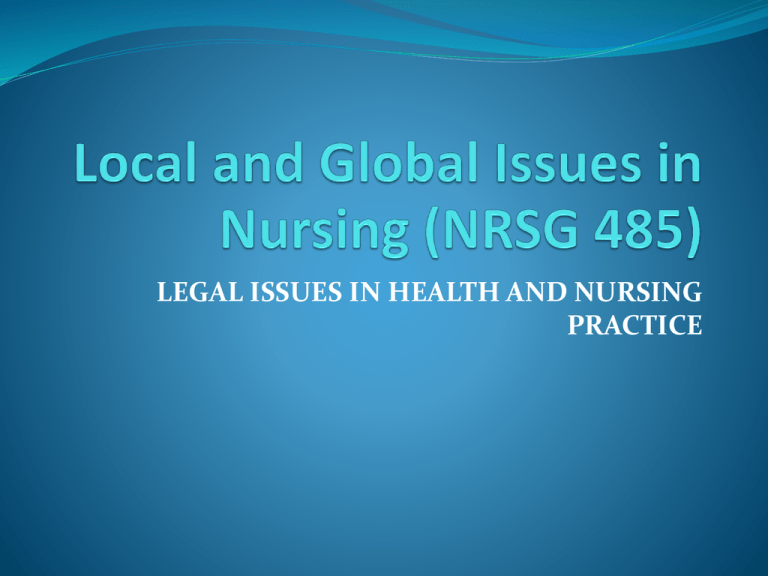
LEGAL ISSUES IN HEALTH AND NURSING PRACTICE INTRODUCTION Legal issues are those that are decided by law Law may be defined as: “A rule of conduct or action prescribed or formally recognized as binding or enforced by a controlling authority” Laws are put in place to ensure that behavior that would threaten public safety is controlled after all other measures to change that behavior have failed INTRODUCTION Ethics are the principles of conduct governing one's relationships with others (basic beliefs about right and wrong) Legal and ethical issues are often discussed together because they go hand in hand, with one supporting the other. CLASSIFICATION OF LAWS Law is divided into civil and criminal components. Both statutory law and common law may be subdivided in this way. Criminal Law Criminal law addresses the general welfare of the public. A violation of criminal law is called a crime, and it is prosecuted by the government. On conviction, a crime may be punishable by imprisonment, a loss of privilege (such as a license), a fine, or any combination of these. The punishment is intended to discipline the violator and deter further such actions by this person as well as discourage others from committing the crime. Criminal Law A crime may be classified as either a misdemeanor (misbehavior) or as a felony (lawbreaking). A misdemeanor is a lesser violation of the law and is punishable by a fine or an imprisonment of less than a year. A felony represents a more serious violation of the law and carries heavier fines and longer periods of imprisonment, and in the most serious of cases, perhaps even death Civil Law Civil law regulates conduct between private individuals and businesses and is enforced through the courts as damages or money compensation. A tort is a violation of a civil law in which another person is wronged. Private individuals or groups may bring a legal action (lawsuit) to court for breach (breaking) of civil law. Nurses may find themselves involved with both civil and criminal laws, either separately or within the same situation. LAW AND THE NURSES Criminal Law and Nursing A violation of any law governing the practice of any licensed profession may be a crime A violation of a professional practice act may be prosecuted as a crime even if no actual harm occurred to the patient Some violations of criminal law are not prosecuted in court but even when not prosecuted in court, criminal action could result in the loss of a job and a license to practice nursing Criminal Law and Nursing Examples include: Diagnosing diseases and prescribe medication: to give a medication without an order is a violation of the law and is a crime, even if doing so does not harm the client Violation of laws related to the care and distribution of controlled substances is also a crime. Altering or changing narcotic records is a crime even if no diversion of drugs occurred. Criminal Law and Nursing Nurses can also commit crimes while in the role of caring for patients. These legal actions may be based on such charges as reckless endangerment and/or criminal negligence Examples include: Leaving hospital at midnight knowing that the nurse for the next shift had not yet arrived might be considered reckless endangerment To leave incapacitated patients without a nurse is abandoning them and is considered reckless because it shows a lack of appropriate regard for the well-being of the patients Criminal Law and Nursing Errors that result in the serious injury or death of a patient are investigated and may be prosecuted and tried by the criminal courts. A license to practice nursing may be temporarily withdrawn while such charges are investigated and tried. If the individual is found innocent, the license then may be restored. If the individual is convicted of the crime, the nursing license may be withdrawn, in addition to sentencing and other penalties Criminal Law and Nursing Nurses who commit felonies such as theft, abuse, or deliberate harm in which a patient is a victim are usually charged under both criminal laws and the laws regulating nursing practice Nurses who commit felonies outside of the care setting can be prosecuted under criminal law and under the law regulating nursing practice if the felony reflects on their fitness to practice nursing ( For example, an individual prosecuted for selling narcotics usually will have action taken under the Nurse Practice Act as well) Civil Law and Nursing Civil law relates to legal disputes between private parties. Malpractice actions brought in health care situations involve civil law. Torts Torts are civil wrongs committed by one person against another person or a person's property The wrong may be physical, psychological or emotional harm, harm to livelihood, or harm to reputation Civil Law and Nursing The action that causes a civil wrong may be either intentional or unintentional An intentional tort is one in which the outcome was planned, although the person involved may not have believed that the intended outcome would be harmful to the other person. Example: Preventing a patient from leaving against medical advice may be based on concern for the patient, but it is illegal and to do so is an intentional tort Civil Law and Nursing The action that causes a civil wrong may be either intentional or unintentional An unintentional tort is a wrong committed against another person or property that was not intended to happen. The most common cause of an unintentional tort is negligence Example: Giving a patient his breakfast on the morning of his abdominal surgery without recording it and not knowing he is schedule for surgery Negligence Negligence is a general term that refers to conduct that does not show due care If harm is caused by negligence, it is termed an unintentional tort and damages may be recovered All negligence has the following four Essential Characteristics: Harm must have occurred to an individual The negligent person must have been in a situation where he or she had a duty toward the person harmed Negligence All negligence Characteristics: has the following four Essential The person must be found to have failed to fulfill his or her duty. This is called “breach of duty” and may include: Commission of an inappropriate action: doing what should not have been done Omission of a necessary or appropriate action: failing to do what should have been done (This is also referred to as failing to act as a reasonably prudent/careful person). A reasonably prudent person in this context means someone who demonstrates careful and thoughtful action. The harm must be shown to have been caused by the breach of duty Malpractice Malpractice is a term used to identify a specific type of negligence. It refers to the negligence of a specially trained or educated person in the performance of his or her job. Malpractice is the term used to describe negligence by nurses and doctors and other health care professionals in the performance of their duties Malpractice Malpractice is a professional negligence Liability resulting from improper practice based on standards of care required by that profession Malpractice Applying the Four Essential negligence to Malpractice: Characteristics of Duty of a professional toward an individual : The professional person must have had a professional duty toward the person receiving the care Breach of duty by the professional: The nurse was performing the professional activities of a nurse for the person needing the care (in either a paid or volunteer capacity) Malpractice Applying the Four Essential negligence to Malpractice: Characteristics of Harm to an individual : The harm that occurred to this person or to the property must be based on a failure to act as a prudent professional and in accordance with professional standards in the situation Breach of duty as the cause of harm: Malpractice is present only if a breach of duty was the cause of the harm Malpractice The presence of harm is often clear (a fractured hip, surgical instrument in the abdomen of a patient). No one will dispute that this is harm. Malpractice is present only if a breach of duty was the cause of the harm. The cause of a fractured hip might be the person's own responsibility, not the responsibility of the nurse or the doctor, but in the case of a surgical instrument left in an abdomen of a patient after surgery and causes harm and infection or even death, there is no way that the instrument could be in the abdomen if the surgical team had not placed it there. Malpractice When the harm is so clear and the responsibility for the harm so straightforward that it does not need to be proved in court, the legal term “the thing speaks for itself” is used and Expert Witnesses would not be needed to make this determination. Always remember that a breach of duty may be either the omission of a correct action or the commission of an incorrect action. Liability A liability is an obligation or debt that can be enforced by law. In the case of malpractice, a person found guilty of any tort (whether intentional or unintentional) is considered legally liable, or legally responsible, for the outcome, and usually is required to pay for damages to the other person. These may include actual costs of care, legal services, loss of earnings (present and future), and compensation for emotional and physical stress suffered. Liability Personal Liability As an educated professional, you are always legally responsible or liable for your actions, “ I will take responsibility for that” means nothing and unwise The physician or supervisor giving the directions may be liable also if harm results, but that would not remove your personal liability ** Refer to Example Case One: Personal Liability Liability Employer Liability The most common situation in which a person or organization is held responsible for the actions of another is in the employer–employee relationship In many instances, an employer can be held responsible for torts committed by an employee Liability Employer Liability The law holds the employer responsible for hiring qualified persons, so if a nurse, as an employee of a hospital, is guilty of malpractice, the hospital also may be named in the suit. It is important to understand that this does not remove any responsibility from the individual nurse, but it extends responsibility to the employer in addition to the nurse. ** Refer to Example Case two: Employer Responsibility for a Staff Nurse Liability Supervisory Liability In the role of clinical leader, charge nurse, unit manager, supervisor, or any other role that involves delegation, supervision, or direction of other people, the nurse is potentially liable for the actions of others The supervising nurse is responsible for exercising good judgment in a supervisory role, including making appropriate decisions about assignments and delegation of tasks. Liability Supervisory Liability If an error occurs and the supervising nurse is shown to have exercised sound judgment in all decisions made in that capacity, the supervising nurse may not be held liable for the error of a subordinate. If poor judgment was used in assigning an inadequately prepared person to an important task or oversight was inadequate, the supervisory nurse might be liable for resulting harm. The extent of the subordinate's responsibility would depend on his or her level of education and training. Liability Supervisory Liability People with limited education or training might not be liable for some errors; the more education subordinates have, the more likely they will be liable ** Refer to Example Case Three: Supervisory Responsibility for an Educated Staff Member And ** Refer to Example Case Four: Supervisory Responsibility for a Staff Member with Limited Education Liability Liability Insurance Liability insurance transfers the legal and any settlement costs related to a suit from the individual to an insurance company, which spreads the risks to a large group of policy holders. Liability Institutional and Individual Insurance Many hospitals and other institutional employers carry liability insurance that covers both the institution and its employees. Some hospitals may limit the coverage that their policies provide for individual employees in an effort to hold down costs.


